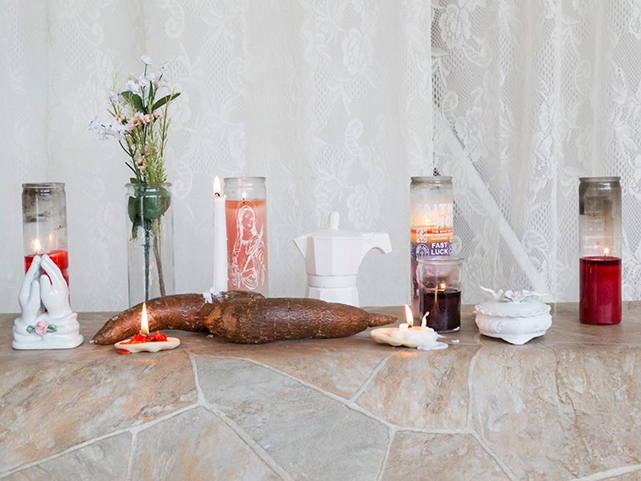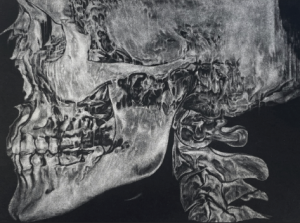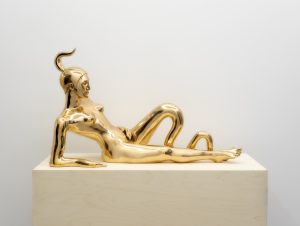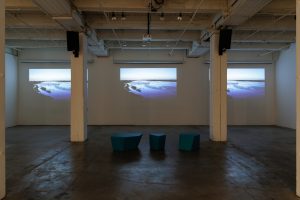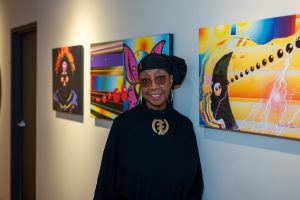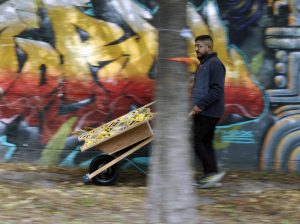I met Fontaine Capel several years ago while working at the MCA. Fontaine was an arts educator, and I worked in the Visitor Services Department. Though our paths only crossed for a brief time before Fontaine left the MCA to build the Humboldt Park communal arts space, Hume, I immensely enjoyed and appreciated our conversations. We spoke about community within the arts, and I deeply admired her drive and dedication towards building safe and equitable communal spaces. Recently I had the opportunity to visit Hume and sit down with a Fontaine to discuss her practice and Hume’s community-driven mission.
Annette LePique: Thank you so much for speaking with me today, Fontaine! It’s been a while since I’ve been to Hume, but do you think that it will always be on Armitage? Or will there be any future expansion?
Fontaine Capel: Thanks so much for stopping by! So, there are a couple of things to note about Hume. We have zero official funding from grants or organizations – we’re entirely self and community supported. The three women who run the space all volunteer our labor and contribute financially each month to make sure rent is paid. We also rent out studio spaces to emerging artists and receive recurring monthly donations from different supporters. Donations usually range from five to fifteen dollars. Which is to say that we are totally dependent on the whims of the rental market. We are all artists, we all have day jobs. Some of us have day jobs under the poverty line. So we will go wherever it is cheap and accessible. Cheap and accessible also must overlap with where folks will be likely to show up to an arts space. This means that we live in places where gentrification is happening. Traditionally, art spaces are the first wave of gentrification. It’s a really tough place to be.
AL: Definitely, navigating that is so tricky.
FC: For me the challenge lies in providing materials and support to underrepresented artists while simultaneously maintaining a level of community accessibility. That means having bilingual signage and engaging with anyone I may see looking into the space but hesitating to enter. Being able to speak Spanish is really important for that. I live in this neighborhood, I’m one of the forces gentrifying this neighborhood, and this space is a force – if we do it wrong – that will absolutely continue the gentrification of this neighborhood. My Latinx family has also been gentrified out of our own neighborhood in Brooklyn, which is actually the subject matter of my current exhibition. We’re constantly thinking about and trying to become better neighbors.
AL: It’s interesting that something we learn at such a young age, “being a good neighbor,” can perhaps play a role in reshaping a narrative of gentrification. When we were speaking about how artists are traditionally that first wave of gentrification there’s potential for new models of community to form when this first wave of people, such as yourself, possess cognizance and criticality towards who is coming and participating at local art spaces. Maybe a better way to state that is, thinking about who feels welcome. What do you think?
FC: Yes, especially when you consider “to whom are you being a good neighbor?” Exclusively catering toward a community whose members moved here as recently as I did, and who already feel comfortable coming into white-walled gallery spaces, is not being a good neighbor.
AL: That’s also a very small sliver of the community and not representative of all potential conversations or participation.
FC: It’s something that we’ve struggled with. It’s something with which we’re still struggling – we have not found a solution. It’s tricky, since we want to highlight work by underrepresented artists, folks who are pushing the envelope through queer or feminist art that may not be easy for passersby to digest. We want to engage in that dialogue and, at the same time, be “good neighbors.” So it’s about talking to people, which is also hard when we all have day jobs and can’t maintain regular hours.
Something else on my mind is that Hume is in a corner storefront in a predominantly Latinx neighborhood, similar to my Cuban grandfather’s corner bodega in 1960’s-70’s Brooklyn. The place we replaced was quite similar to his bodega. How do we support artists who don’t get funding, space, or recognition from institutions because of financial barriers? How do we create our own structures so we don’t have to look to exterior established institutions for validation, while not alienating or aiding in the displacement of the community around us? That’s the tension.
AL: Questions of age and technology intersect this tension in an interesting way. Thinking about what you said regarding Hume’s support of artists who make challenging work, many younger folks in the neighborhood who grew up with internet access may have an interest in art that is not easily digested. Though computer knowledge and internet access, of course, have their own issues pertaining to accessibility. However, technology’s presence in one’s life is beneficial towards cultivating a curiosity and a vocabulary with which to ask questions and begin difficult conversations. Older folks may not have had access to those same resources, and without those tools, challenging conversations can be difficult to begin.
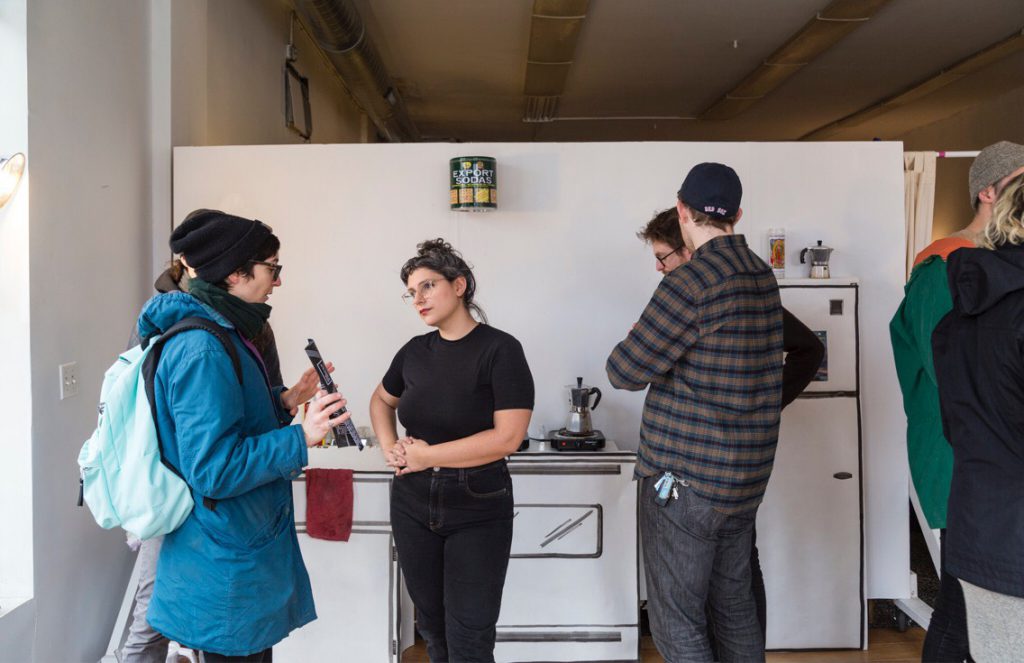
FC: Yeah, totally. When we began building out the space, there were these kids who lived down the street who always watched us. From putting down flooring to painting the walls, they would always come around and ask, “What are you doing?” They are welcome any time, all the time. When I’m working in my studio, they come in. When we have openings, they come in and not even with their parents! They also touch everybody’s shit, which is fine, until it’s not. (They haven’t hung out in many art studios, so we’ve had to talk about not playing with things that don’t belong to you.) My experience as an arts educator at the MCA and Marwen has been really helpful in both having really interesting conversations and establishing boundaries with these kids. It’s a juggling act. Ultimately my wish is that they feel confident in asking difficult questions in a space that has been historically unfriendly to children. I hope that Hume can help unpack many of the hierarchies of the “white-walled gallery.”
AL: Definitely! Especially with the moneyed gallery system being populated by white people, rich white people, white guys, rich white guys, etc.
FC: Yeah, and we have zero rich white guys in this entire situation, and that’s great!
I chose the iconography in this specific installation because it will be familiar to Latin American immigrants from the Caribbean, including Cuban and Puerto Rican folks. It’s been really great to be able to sit and meet people. Some women came by while I was holding open hours the other day and asked me about the space. I explained it was an art gallery. They started asking questions and said they weren’t going to come in here but they recognized the Export Sodas and Galletas (Cuban crackers). They’re Latina, and they grew up across the street. They asked me if my landlady still owned the building and if her grandson still lived upstairs. They called her and joked that it was her underwear hanging up on the wall. It was so lovely and affirming that they came in and thought that the exhibition was great. One of them understood that all of these things were art, but the other kept asking if I knew about these items. I said, “Yes this is my work, and these are the foods and experiences with which I grew up.” It is affirming to be able to signal to other Latinx’s that this space is a place where you can engage. This is art that speaks directly to aspects of your experience and hopes to recontextualize it and its iconography to “fine art” in a white-walled gallery.
AL: The representation of those experiences as well is critical.
FC: Right, and representation intersects with white audiences in an interesting way as it prompts them to ask questions. The white people who have come in ask, “What are these crackers? What brand of coffee is that, I’ve never had it before?” Or even, “What material is on the floor?” I let them know that this is vinyl. I grew up with this and not wood. It’s been personally important for me as someone who exists in this community and runs a space to say this is me, and this is how I grew up.
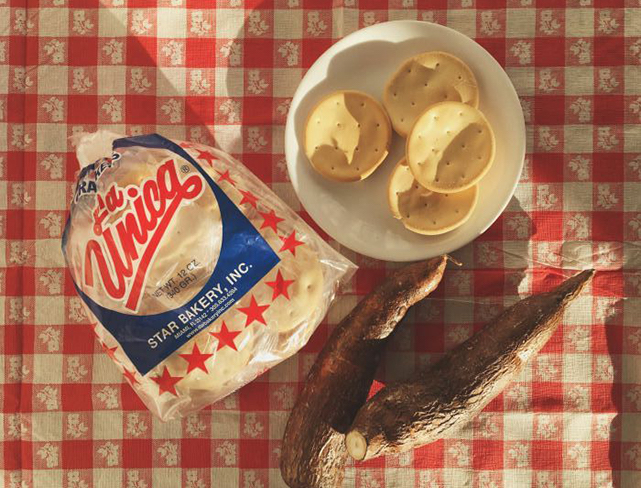
AL: People were confused by linoleum or vinyl?
FC: Yes. I’ve actually been thinking about linoleum. I grew up on the second floor of a beautiful old brick row house from turn-of-the-century Brooklyn. Though it was beautiful there were layers of linoleum. Everything had been painted over a million times; there were layers of wallpaper and linoleum floors. As a little kid I remember peeling and peeling endless layers of linoleum. I thought that that was normal until I went to my private school friends’ houses and they had wooden floors. I thought it was a normal experience, but it’s a marked difference between people who grew up with a specific type of not-wealth. (Though I’m sure there are countless people with wood floors who are not wealthy.) I read it as a very specific urban experience with landlords, low cost buildings, and painted plugs. Essentially all of these signifiers that others own the space in which you live.
So I’ve been able to have conversations around not just race, ethnicity, and immigrant status, but for the first time, wealth.
AL: The intersections between those topics, as well, are also interesting to consider.
FC: It’s been gratifying and is just the surface of experiences to discuss and explore.
AL: One intersection is that between white-walled galleries and institutions. I came to Chicago for SAIC and immediately became aware of my privileged access to resources, jobs, and connections that would not have otherwise been available. It’s highly problematic because if someone does not have access to institutions, like art schools or museums, it would then be difficult for them to feel comfortable in the art spaces and galleries intimately connected to those same schools and museums. Access to these institutions is a form of privilege. My friend told me a story that one day in class a professor asked the students if any had seen the latest show in the Louvre, and about ten kids raised their hands. This seems like a ridiculous question, but it perfectly sums up assumptions of access.
FC: Yeah, but that’s the art world. That question is a perfect example of the classism and privilege tied to accessibility. Such assumptions also play a role in micro aggressions. They are especially insidious in institutions that are supposed to facilitate your learning. I’ve experienced them firsthand, and it undermines one’s confidence.
AL: Especially because it places the burden of change on you. Instead of an apology and institutional change, you have to worry about how others will react.
FC: If you will be spoken of in a negative light…
AL: Something that could definitely hurt you in the long run.
FC: It’s also funny what can happen in institutions without pushback just because someone with institutional power says, “Oh this must be fine,” and everyone says, “Oh great, this must be fine.” I’m reminded of the outcry over the MCA around a year ago because of their exhibition on the Latinx experience. The exhibition featured artists from the West Coast and no one from Pilsen or Little Village. It’s hard to challenge institutions and hold them accountable.
AL: There’s almost no criticality. Once a place reaches a certain size and enough money is circulated there’s very little hindsight.
FC: That is both reflected in how those places deal with exhibitions and the artists they employ. Major institutions have structures that are harmful to artists and equitable support systems.
This complete lack of understanding or will to listen or change or support artists is really frustrating. There needs to be an alternative to these inertia-filled installations with high barriers to entry. That’s why so many artist-run spaces have opened, and that’s what Hume is doing. That’s why this is necessary.
Hear Fontaine Capel speak on Saturday, April 22nd at 4:30pm for “Fresh Walls: New Space for Artists to Occupy” at the Lake FX CreativeCon–the largest free summit for artists across disciplines in the midwest.
Featured Image: Installation view of Fontaine Capel’s “Por La Mañana,” Hume (2017).
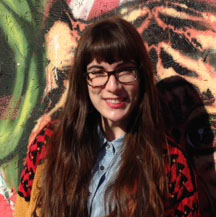 Annette LePique is a Chicago-based art historian and writer. She received her M.A. from the School of the Art Institute of Chicago in Modern and Contemporary Art History. She presented her research on gender, performativity and new media at Concordia University’s 2015 Constellations Clusters Networks Conference in Montreal.
Annette LePique is a Chicago-based art historian and writer. She received her M.A. from the School of the Art Institute of Chicago in Modern and Contemporary Art History. She presented her research on gender, performativity and new media at Concordia University’s 2015 Constellations Clusters Networks Conference in Montreal.
